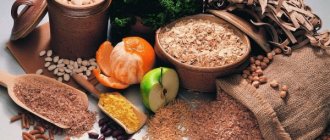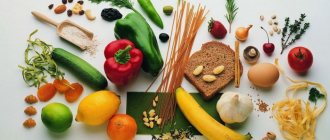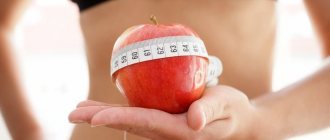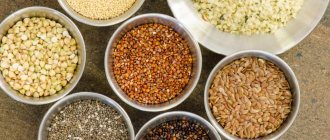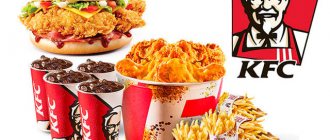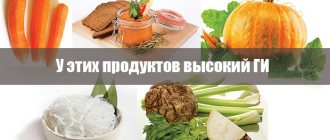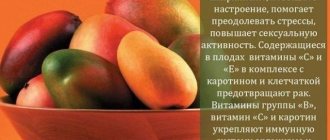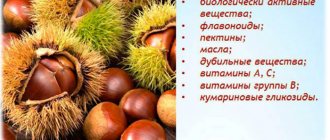A rational, balanced diet, which includes in the daily diet the optimal amount of proteins, fats and carbohydrates, which are very important for proper functioning, is essential in a person’s life. To lose weight, the human body needs amino acids - strong structures concentrated in protein. Through the digestive system, the body breaks down a chain of amino acids to absorb them into the blood. During this time, our body works on digestion, which means that the metabolism does not slow down. That is why protein foods must be included in the list of foods for weight loss.
Importance for the body
Proteins are the main part of the cells of all organs and tissues. Protein is associated with life processes such as metabolism, irritability, growth, reproduction and even thinking.
Flaw
A lack of protein will lead to a deterioration in the body's condition, which is manifested in reduced protection against infections and performance, a drop in immunity, a sharp deterioration in the condition of nails, skin, hair, disruption of the liver, small intestine, nervous and endocrine systems.
For children and adolescents, a lack of protein in the body leads to slower growth and mental development. Therefore, every person needs to know which foods are the most protein-rich in order to control the level of the component in the body.
Oversupply
However, an excess of protein will also not bring anything good, since the accumulation of protein in the body without lack of exercise leads to loss of calcium.
Why is protein so important?
The amino acids that make up the substance are necessary for:
- cell restoration;
- building muscle tissue;
- maintaining hair, nails and skin in a healthy condition.
Protein nutrition is especially important for:
- children, since their bodies are constantly growing;
- pregnant women, because with a lack of protein nutrition, fetal development slows down;
- athletes and people who go to the gym, since such a diet promotes the growth of muscle mass.
You need to consume 2 g of protein per 1 kg of body weight per day. These products should make up 40% of the total food. The main supplier is food of animal origin.
Pros of protein nutrition
A protein-rich diet is popular due to its effectiveness. Protein, even if it comes in excess, is not converted into fat, but is excreted from the body. Therefore, such products form the basis of the diet, and carbohydrates and fats are kept to a minimum.
The advantages of this diet include:
- Weight loss. The body takes energy by breaking down fats accumulated in the body.
- No feeling of hunger, because protein foods are filling.
- Improved appearance: healthy hair and nails.
- Positive effect on muscle tissue.
Despite all the usefulness of protein products, the diet should not consist entirely of them.
Fast and slow proteins
Depending on the rate of breakdown and absorption, it is customary to distinguish fast and slow proteins.
If a category where a food is high in protein has a protein absorption coefficient of less than or equal to 1, then that food is the richest source of protein.
Slow
Slow proteins are proteins that take a long time to be broken down by the body, helping you lose weight and stay in a full state for a long time. It is imperative to remember what long-term proteins are contained in; the list of products is indeed very large, but below are the most basic ones.
Slow proteins break down into amino acids in about 6 hours, because they contain fewer calories, and their breakdown requires much more energy. Therefore, long-term proteins are often consumed for dinner 2-3 hours before bedtime, then the body will have enough time during the night to digest food, while the muscles are fully enriched with amino acids.
List of slow proteins in food in the table:
| Protein source | Amount of protein in 100 g | Splitting factor |
| Peanut | 26 | 0,5 |
| Peas | 23 | 0,7 |
| Beans | 22 | 0,7 |
| Cottage cheese | 17 | 0,7 |
| Wheat | 13 | 0,6 |
Fast squirrels
Fast protein is very useful for athletes, as it restores strength and energy, helps you feel more energetic, and also promotes muscle gain. The body needs only 60-80 minutes to absorb fast proteins.
List of fast protein products in the table:
| Protein source | Amount of protein in 100 g | Splitting factor |
| Cheese | 25 | 1 |
| Pink salmon fish | 25 | 0,9 |
| Chicken | 20-28 | 0,9 |
| Beef lean | 26 | 0,9 |
| Egg | 13 | 1 |
| Kefir, milk | 3-3,6 | 1 |
How to combine them
When consuming protein of different origins at the same time, the digestive secretions need to secrete different types of gastric juice at different times.
If at lunch, for example, you eat meat, milk and eggs, which have unequal digestion times, the digestion time of the egg will slow down, although it itself breaks down in 1 hour.
The most efficient digestion of protein occurs if each protein product is digested separately.
List of low-calorie foods for weight loss
The list of products that will facilitate the process of losing weight is quite large. Some examples of the most common types of food include:
- water;
- greens, parsley, lettuce, spinach;
- cauliflower, broccoli;
- eggs;
- legumes - black beans, lentils, green beans;
- tomatoes, sweet peppers and other vegetables;
- varieties of lean meat;
- mushrooms;
- cottage cheese and fermented milk products;
- unsweetened fruits such as citrus fruits;
- water, green tea.
To improve metabolism
Not all people have the same metabolic process, and for many, metabolism slows down significantly after 30 years. With the same diet, reduced metabolism does not allow the body to cope with stress and the end result of overeating can be obesity.
To prevent this from happening, you need to take a radical approach to compiling your daily menu and start consuming foods that speed up your metabolism.
Metabolism-boosting foods fall into several categories:
- Drinks - plain water or with lemon, natural coffee, green tea;
- Dairy - kefir, low-fat yogurt;
- Protein - dietary meat and fish;
- Plant foods - broccoli, spinach, cabbage;
- Vegetables and fruits - apples, peppers, citrus fruits;
- Seasonings - cinnamon, red pepper.
The best dietary patterns include the following products that improve metabolism and promote weight loss :
- Eggs . They are rich in protein and will also not cause harm to the body, since they have virtually no effect on cholesterol levels;
- Green leaves. Having almost zero calories, green leaves will increase serving size, speed up satiety, while keeping the calorie content of the dish low;
- Fatty fish. Healthy fish oil and Omega acids help you quickly fill up without being overloaded with extra calories;
- Cruciferous vegetables. Rich in protein and fiber, allowing you to quickly fill up;
- Lean meat. Low-calorie meats include some types of beef, turkey, rabbit and chicken;
- Boiled potatoes. Despite the widespread belief that potatoes are useless, one cannot deny the variety of microelements and vitamins that they contain. A potato dish is a complete lunch, but low in calories;
- Legumes. Lentils and beans, due to their high percentage of protein and fiber, quickly make a person feel full;
- Soups. Half of these dishes consist of liquid, which contains almost no calories.
Some products are classified as fat burners because they have negative calories. Fat burner products for weight loss do not provide the body with excess proteins, carbohydrates and fats, and to digest them you need to spend much more resources than they provide. The energy for this is taken from stored fats, which means a person eats in order to lose weight.
Fat burning products for weight loss:
- celery stalk;
- cucumbers;
- greenery;
- currants, blueberries;
- grapefruits;
- apples;
- green tea;
- garlic.
Protein products
Protein foods that are good for weight loss and don't contain many calories include animal products and dairy products. For the most effective weight loss without compromising your health, you should include the following list of protein foods for weight loss in your daily menu.
Protein food for weight loss - list of products:
- chicken fillet;
- veal;
- beef;
- chicken eggs;
- turkey meat;
- horsemeat.
- Dairy and fermented milk:
- cottage cheese with different percentages of fat;
- kefir;
- curdled milk;
- milk.
Carbohydrate-containing products
Fast carbohydrates are instantly broken down and raise blood sugar levels. This burst of energy is good after hard physical labor or sports training; it restores strength. But in the process of losing weight , this food is strictly prohibited, its consumption is limited in order to avoid breakdowns .
Basic food with fast carbohydrates:
- all confectionery products;
- sugar, honey;
- sweet fruits and berries;
- chocolate;
- ice cream;
- alcohol and sweet drinks;
- White bread;
- White rice;
- potato.
Slow carbohydrates have the opposite effect . This is the name given to substances that have a low glycemic index . Food containing these carbohydrates has a beneficial effect on the digestion process, contains fiber and quickly brings the body to a state of satiety. Slow carbohydrates are not easy to break down, so the body will need time to digest this food . Quick satiation and a feeling of fullness for a long time will help you follow your diet exactly and achieve good results when losing weight. This list of carbohydrates for weight loss will help you create the right menu.
The list of complex carbohydrates includes the following foods:
- buckwheat;
- rice;
- beans;
- peas;
- pearl barley;
- Rye bread;
- durum pasta.
Low glycemic index foods
In science, the glycemic index is an indicator of the effect of food on the level of glucose contained in the blood. The lower the index, the less the nutrient increases glucose . For people trying to lose weight, foods with the lowest glycemic index are recommended.
Low glycemic index foods:
- legumes;
- cereals, except semolina;
- unsweetened fruits and berries;
- wholemeal bread;
- whole grain wheat pasta.
- mushrooms.
Low glycemic index foods for weight loss - table:
| Products | GI (Glycemic index) |
| Sweet potatoes (yams, yams) | 50 |
| Buckwheat (green, without pre-frying) | 50 |
| Basmati rice | 50 |
| Cranberry juice (no sugar) | 50 |
| Oranges | 50 |
| Kiwi | 50 |
| Mango | 50 |
| Brown brown rice | 50 |
| Apple juice (no sugar) | 50 |
| Grapefruit | 45 |
| Coconut | 45 |
| Fresh orange juice | 45 |
| Whole grain toast | 45 |
| Dried figs | 40 |
| Pasta cooked al dente | 40 |
| Carrot juice (no sugar) | 40 |
| Dried apricots | 40 |
| Prunes | 40 |
| Fresh apple | 35 |
| Fresh plum | 35 |
| Fresh quince | 35 |
| Low-fat natural yogurt | 35 |
| Wild (black) rice | 35 |
| Beans | 35 |
| Fresh nectarine | 35 |
| Pomegranate | 35 |
| Fresh peach | 35 |
| Tomato juice | 30 |
| Fresh apricot | 30 |
| Pearl barley | 30 |
| Brown lentils | 30 |
| Green bean | 30 |
| Fresh pear | 30 |
| Tomato (fresh) | 30 |
| Low-fat cottage cheese | 30 |
| Yellow lentils | 30 |
| Blueberries, lingonberries, blueberries | 30 |
| Dark chocolate (more than 70% cocoa) | 30 |
| Milk (any fat content) | 30 |
| passion fruit | 30 |
| Fresh mandarin | 30 |
| Blackberry | 25 |
| Cherry | 25 |
| Green and red lentils | 25 |
| Golden beans | 25 |
| Fresh raspberries | 25 |
| Red Ribes | 25 |
| Soy flour | 25 |
| Strawberry wild-strawberry | 25 |
| Pumpkin seeds | 25 |
| Gooseberry | 25 |
| Peanut butter (no sugar) | 20 |
| Artichoke | 20 |
| Eggplant | 20 |
| Soy yogurt | 20 |
| Almond | 15 |
| Broccoli | 15 |
| Cabbage | 15 |
| Cashew | 15 |
| Celery | 15 |
| Bran | 15 |
| Brussels sprouts | 15 |
| Cauliflower | 15 |
| Chilli | 15 |
| Fresh cucumber | 15 |
| Hazelnuts, pine nuts, pistachios, walnuts | 15 |
| Asparagus | 15 |
| Ginger | 15 |
| Mushrooms | 15 |
| Zucchini | 15 |
| Onion | 15 |
| Pesto | 15 |
| Leek | 15 |
| Olives | 15 |
| Peanut | 15 |
| Rhubarb | 15 |
| Tofu (bean curd) | 15 |
| Soybeans | 15 |
| Spinach | 15 |
| Leaf salad | 10 |
| Parsley, basil | 5 |
| Vanillin, cinnamon, oregano | 5 |
Table “calorie content of foods per 100 grams for weight loss”
The process of removing extra pounds from the body by creating a calorie deficit is a rather complex phenomenon in which many details need to be taken into account when creating a dietary menu. To avoid confusion, it is better to include the most important foods for weight loss in a special list, and tables of caloric content of foods will help you with this.
Calorie table: (number of calories in 100 grams):
Milk and dairy:
| Product | Water, g | Proteins, g | Fats, g | Carbohydrates, g | kcal |
| Cow's milk cheese | 52,0 | 17,9 | 20,1 | 0,0 | 260 |
| Natural yoghurt 1.5% fat | 88,0 | 5,0 | 1,5 | 3,5 | 51 |
| Low-fat kefir | 91,4 | 3,0 | 0,1 | 3,8 | 30 |
| Full fat kefir | 88,3 | 2,8 | 3,2 | 4,1 | 59 |
| Milk | 88,5 | 2,8 | 3,2 | 4,7 | 58 |
| Acidophilus milk | 81,7 | 2,8 | 3,2 | 10,8 | 83 |
| Whole milk powder | 4,0 | 25,6 | 25,0 | 39,4 | 475 |
| Condensed milk | 74,1 | 7,0 | 7,9 | 9,5 | 135 |
| Condensed milk with sugar | 26,5 | 7,2 | 8,5 | 56,0 | 315 |
| Curdled milk | 88,4 | 2,8 | 3,2 | 4,1 | 58 |
| Ryazhenka | 85,3 | 3,0 | 6,0 | 4,1 | 85 |
| Cream 10% | 82,2 | 3,0 | 10,0 | 4,0 | 118 |
| Cream 20% | 72,9 | 2,8 | 20,0 | 3,6 | 205 |
| Sour cream 10% | 82,7 | 3,0 | 10,0 | 2,9 | 116 |
| Sour cream 20% | 72,7 | 2,8 | 20,0 | 3,2 | 206 |
| Special cheeses and curd mass | 41,0 | 7,1 | 23,0 | 27,5 | 340 |
| Russian cheese | 40,0 | 23,4 | 30,0 | 0,0 | 371 |
| Dutch cheese | 38,8 | 26,8 | 27,3 | 0,0 | 361 |
| Swiss cheese | 36,4 | 24,9 | 31,8 | 0,0 | 396 |
| Poshekhonsky cheese | 41,0 | 26,0 | 26,5 | 0,0 | 334 |
| Processed cheese | 55,0 | 24,0 | 13,5 | 0,0 | 226 |
| Fat cottage cheese | 64,7 | 14,0 | 18,0 | 1,3 | 226 |
| Cottage cheese semi-fat | 71,0 | 16,7 | 9,0 | 1,3 | 156 |
| Low-fat cottage cheese | 77,7 | 18,0 | 0,6 | 1,5 | 86 |
Bakery products, flour
| Product | Water, g | Proteins, g | Fats, g | Carbohydrates, g | kcal |
| Rye bread | 42,4 | 4,7 | 0,7 | 49,8 | 214 |
| Wheat bread from grade I flour | 34,3 | 7,7 | 2,4 | 53,4 | 254 |
| Butter pastries | 26,1 | 7,6 | 4,5 | 60,0 | 297 |
| Baranki | 17,0 | 10,4 | 1,3 | 68,7 | 312 |
| Drying | 12,0 | 11,0 | 1,3 | 73,0 | 330 |
| Wheat crackers | 12,0 | 11,2 | 1,4 | 72,4 | 331 |
| Cream crackers | 8,0 | 8,5 | 10,6 | 71,3 | 397 |
| Premium wheat flour | 14,0 | 10,3 | 0,9 | 74,2 | 327 |
| Wheat flour, grade I | 14,0 | 10,6 | 1,3 | 73,2 | 329 |
| Wheat flour, grade II | 14,0 | 11,7 | 1,8 | 70,8 | 328 |
| Rye flour | 14,0 | 6,9 | 1,1 | 76,9 | 326 |
Cereals
| Product | Water | Squirrels | Fats | Carbohydrates | kcal |
| Buckwheat core | 14,0 | 12,6 | 2,6 | 68,0 | 329 |
| Buckwheat done | 14,0 | 9,5 | 1,9 | 72,2 | 326 |
| Manna | 14,0 | 11,3 | 0,7 | 73,3 | 326 |
| Oatmeal | 12,0 | 11,9 | 5,8 | 65,4 | 345 |
| Pearl barley | 14,0 | 9,3 | 1,1 | 73,7 | 324 |
| Millet | 14,0 | 12,0 | 2,9 | 69,3 | 334 |
| Rice | 14,0 | 7,0 | 0,6 | 73,7 | 323 |
| Wheat “Poltavskaya” | 14,0 | 12,7 | 1,1 | 70,6 | 325 |
| Oatmeal | 10,0 | 12,2 | 5,8 | 68,3 | 357 |
| Barley | 14,0 | 10,4 | 1,3 | 71,7 | 322 |
| Hercules | 12,0 | 13,1 | 6,2 | 65,7 | 355 |
| Corn | 14,0 | 8,3 | 1,2 | 75,0 | 325 |
Vegetables
| Product | Water, g | Proteins, g | Fats, g | Carbohydrates, g | kcal |
| Eggplant | 91,0 | 0,6 | 0,1 | 5,5 | 24 |
| Swede | 87,5 | 1,2 | 0,1 | 8,1 | 37 |
| Green peas | 80,0 | 5,0 | 0,2 | 13,3 | 72 |
| Zucchini | 93,0 | 0,6 | 0,3 | 5,7 | 27 |
| White cabbage | 90,0 | 1,8 | — | 5,4 | 28 |
| Red cabbage | 90,0 | 1,8 | — | 6,1 | 31 |
| Cauliflower | 90,9 | 2,5 | — | 4,9 | 29 |
| Potato | 76,0 | 2,0 | 0,1 | 19,7 | 83 |
| Green onion (feather) | 92,5 | 1,3 | — | 4,3 | 22 |
| Leek | 87,0 | 3,0 | — | 7,3 | 40 |
| Bulb onions | 86,0 | 1,7 | — | 9,5 | 43 |
| Red carrots | 88,5 | 1,3 | 0,1 | 7,0 | 33 |
| Ground cucumbers | 95,0 | 0,8 | — | 3,0 | 15 |
| Greenhouse cucumbers | 96,5 | 0,7 | — | 1,8 | 10 |
| Sweet green pepper | 92,0 | 1,3 | — | 4,7 | 23 |
| Sweet red pepper | 91,0 | 1,3 | — | 5,7 | 27 |
| Parsley (greens) | 85,0 | 3,7 | — | 8,1 | 45 |
| Parsley (root) | 85,0 | 1,5 | — | 11,0 | 47 |
| Rhubarb (petiole) | 94,5 | 0,7 | — | 2,9 | 16 |
| Radish | 93,0 | 1,2 | — | 4,1 | 20 |
| Radish | 88,6 | 1,9 | — | 7,0 | 34 |
| Turnip | 90,5 | 1,5 | — | 5,9 | 28 |
| Salad | 95,0 | 1,5 | — | 2,2 | 14 |
| Beet | 86,5 | 1,7 | — | 10,8 | 48 |
| Tomatoes (ground) | 93,5 | 0,6 | — | 4,2 | 19 |
| Tomatoes (greenhouse) | 94,6 | 0,6 | — | 2,9 | 14 |
| Green beans (pod) | 90,0 | 4,0 | — | 4,3 | 32 |
| Horseradish | 77,0 | 2,5 | — | 16,3 | 71 |
| Cheremsha | 89,0 | 2,4 | — | 6,5 | 34 |
| Garlic | 70,0 | 6,5 | — | 21,2 | 106 |
| Spinach | 91,2 | 2,9 | — | 2,3 | 21 |
| Sorrel | 90,0 | 1,5 | — | 5,3 | 28 |
Fruits and berries
| Product | Water, gram | Proteins, grams | Fats, grams | Carbohydrates, grams | kcal |
| Apricots | 86,0 | 0,9 | — | 10,5 | 46 |
| Quince | 87,5 | 0,6 | — | 8,9 | 38 |
| Cherry plum | 89,0 | 0,2 | — | 7,4 | 34 |
| A pineapple | 86,0 | 0,4 | — | 11,8 | 48 |
| Bananas | 74,0 | 1,5 | — | 22,4 | 91 |
| Cherry | 85,5 | 0,8 | — | 11,3 | 49 |
| Pomegranate | 85,0 | 0,9 | — | 11,8 | 52 |
| Pear | 87,5 | 0,4 | — | 10,7 | 42 |
| Figs | 83,0 | 0,7 | — | 13,9 | 56 |
| Dogwood | 85,0 | 1,0 | — | 9,7 | 45 |
| Peaches | 86,5 | 0,9 | — | 10,4 | 44 |
| Rowan garden | 81,0 | 1,4 | — | 12,5 | 58 |
| Rowan chokeberry | 80,5 | 1,5 | — | 12,0 | 54 |
| Garden plum | 87,0 | 0,8 | — | 9,9 | 43 |
| Dates | 20,0 | 2,5 | — | 72,1 | 281 |
| Persimmon | 81,5 | 0,5 | — | 15,9 | 62 |
| Cherries | 85,0 | 1,1 | — | 12,3 | 52 |
| Mulberry | 82,7 | 0,7 | — | 12,7 | 53 |
| Apples | 86,5 | 0,4 | — | 11,3 | 46 |
| Orange | 87,5 | 0,9 | — | 8,4 | 38 |
| Grapefruit | 89,0 | 0,9 | — | 7,3 | 35 |
| Lemon | 87,7 | 0,9 | — | 3,6 | 31 |
| Mandarin | 88,5 | 0,8 | — | 8,6 | 38 |
| Cowberry | 87,0 | 0,7 | — | 8,6 | 40 |
| Grape | 80,2 | 0,4 | — | 17,5 | 69 |
| Blueberry | 88,2 | 1,0 | — | 7,7 | 37 |
| Blackberry | 88,0 | 2,0 | — | 5,3 | 33 |
| Strawberries | 84,5 | 1,8 | — | 8,1 | 41 |
| Cranberry | 89,5 | 0,5 | — | 4,8 | 28 |
| Gooseberry | 85,0 | 0,7 | — | 9,9 | 44 |
| Raspberries | 87,0 | 0,8 | — | 9,0 | 41 |
| Cloudberry | 83,3 | 0,8 | — | 6,8 | 31 |
| Sea buckthorn | 75,0 | 0,9 | — | 5,5 | 30 |
| White currant | 86,0 | 0,3 | — | 8,7 | 39 |
| Red currants | 85,4 | 0,6 | — | 8,0 | 38 |
| Black currant | 85,0 | 1,0 | — | 8,0 | 40 |
| Blueberry | 86,5 | 1,1 | — | 8,6 | 40 |
| Fresh rosehip | 66,0 | 1,6 | — | 24,0 | 101 |
| Dried rose hips | 14,0 | 4,0 | — | 60,0 | 253 |
Dried fruits
| Product | Water | Squirrels | Fats | Carbohydrates | kcal |
| Dried apricots | 18,0 | 5,0 | — | 67,5 | 278 |
| Dried apricots | 20,2 | 5,2 | — | 65,9 | 272 |
| Raisins with pit | 19,0 | 1,8 | — | 70,9 | 276 |
| Raisins sultanas | 18,0 | 2,3 | — | 71,2 | 279 |
| Cherry | 18,0 | 1,5 | — | 73,0 | 292 |
| Pear | 24,0 | 2,3 | — | 62,1 | 246 |
| Peaches | 18,0 | 3,0 | — | 68,5 | 275 |
| Prunes | 25,0 | 2,3 | — | 65,6 | 264 |
| Apples | 20,0 | 3,2 | — | 68,0 | 273 |
Legumes
| Product | Water | Squirrels | Fats | Carbohydrates | kcal |
| Beans | 83,0 | 6,0 | 0,1 | 8,3 | 58 |
| Peas | 14,0 | 23,0 | 1,6 | 57,7 | 323 |
| Whole peas | 14,0 | 23,0 | 1,2 | 53,3 | 303 |
| Soybeans | 12,0 | 34,9 | 17,3 | 26,5 | 395 |
| Beans | 14,0 | 22,3 | 1,7 | 54,5 | 309 |
| Lentils | 14,0 | 24,8 | 1,1 | 53,7 | 310 |
Eggs
| Product | Water | Belk. | Fats | Carbohydrates | kcal |
| Chicken egg | 74,0 | 12,7 | 11,5 | 0,7 | 157 |
| Egg powder | 6,8 | 45 | 37,3 | 7,1 | 542 |
| Protein powder | 12,1 | 73,3 | 1,8 | 7 | 336 |
| Dry yolk | 5,4 | 34,2 | 52,2 | 4,4 | 623 |
| Quail egg | 73,3 | 11,9 | 13,1 | 0,6 | 168 |
Fish and seafood
| Product | Water | Belk. | Fats | Carbohydrates | kcal |
| Gobies | 70,8 | 12,8 | 8,1 | 5,2 | 145 |
| Pink salmon | 70,5 | 21 | 7 | 0 | 147 |
| Flounder | 79,5 | 16,1 | 2,6 | 0 | 88 |
| crucian carp | 78,9 | 17,7 | 1,8 | 0 | 87 |
| Carp | 79.1 | 16 | 3.6 | 0 | 96 |
| Chum salmon | 71.3 | 22 | 5.6 | 0 | 138 |
| Smelt | 79.8 | 15.5 | 3.2 | 0 | 91 |
| Icy | 81.8 | 15.5 | 1.4 | 0 | 75 |
| Bream | 77.7 | 17.1 | 4.1 | 0 | 105 |
| Salmon | 62.9 | 20.8 | 15.1 | 0 | 219 |
| Macrurus | 85 | 13.2 | 0.8 | 0 | 60 |
| Lamprey | 75 | 14.7 | 11.9 | 0 | 166 |
| Pollock | 80.1 | 15.9 | 0.7 | 0 | 70 |
| capelin | 75 | 13.4 | 11.5 | 0 | 157 |
| Navaga | 81.1 | 16.1 | 1 | 0 | 73 |
| Burbot | 79.3 | 18.8 | 0.6 | 0 | 81 |
| Marbled notothenia | 73.4 | 14.8 | 10.7 | 0 | 156 |
| Sea bass | 75.4 | 17.6 | 5.2 | 0 | 117 |
| River perch | 79.2 | 18.5 | 0.9 | 0 | 82 |
| Sturgeon | 71.4 | 16.4 | 10.9 | 0 | 164 |
| Halibut | 76.9 | 18.9 | 3 | 0 | 103 |
| Blue whiting | 81.3 | 16.1 | 0.9 | 0 | 72 |
| Saber fish | 75.2 | 20.3 | 3.2 | 0 | 110 |
| Caspian fisherman | 77 | 19.2 | 2.4 | 0 | 98 |
| Carp | 75.3 | 18.4 | 5.3 | 0 | 121 |
| Large saury | 59.8 | 18.6 | 20.8 | 0 | 262 |
| Small saury | 71.3 | 20.4 | 0.8 | 0 | 143 |
| Salaka | 75.4 | 17.3 | 5.6 | 0 | 121 |
| Herring | 62.7 | 17.7 | 19.5 | 0 | 242 |
| Whitefish | 72.3 | 19 | 7.5 | 0 | 144 |
| Mackerel | 71.8 | 18 | 9 | 0 | 153 |
| Som | 75 | 16.8 | 8.5 | 0 | 144 |
| Horse mackerel | 74.9 | 18.5 | 5 | 0 | 119 |
| Sterlet | 74.9 | 17 | 6.1 | 0 | 320 |
| Zander | 78.9 | 19 | 0.8 | 0 | 83 |
| Cod | 80.7 | 17.5 | 0.6 | 0 | 75 |
| Tuna | 74 | 22,7 | 0,7 | 0 | 96 |
| coal fish | 71.5 | 13.2 | 11.6 | 0 | 158 |
| Sea eel | 77.5 | 19.1 | 1.9 | 0 | 94 |
| Acne | 53.5 | 14.5 | 30.5 | 0 | 333 |
| Hake | 79.9 | 16.6 | 2.2 | 0 | 86 |
| Pike | 70.4 | 18.8 | 0.7 | 0 | 82 |
| Ide | 80.1 | 18.2 | 0.3 | 0 | 117 |
| Far Eastern shrimp | 64,8 | 28,7 | 1,2 | 0 | 134 |
| Cod liver | 26,4 | 4,2 | 65,7 | 0 | 613 |
| Squid | 80,3 | 18 | 0,3 | 0 | 75 |
| Crab | 81,5 | 16 | 0,5 | 0 | 69 |
| Shrimp | 77,5 | 18 | 0,8 | 0 | 83 |
| Sea kale | 88 | 0,9 | 0,2 | 3,0 | 5 |
| Pasta “Ocean” | 72,2 | 18,9 | 6,8 | 0 | 137 |
| Trepang | 89,4 | 7,3 | 0,6 | 0 | 35 |
Caviar
| Product | Water | Squirrels | AND | Angle | kcal |
| Chum salmon granular | 46,9 | 31,6 | 13,8 | 0 | 251 |
| Bream punch | 58 | 24,7 | 4,8 | 0 | 142 |
| Pollock punch | 63,2 | 28,4 | 1,9 | 0 | 131 |
| Sturgeon granular | 58 | 28,9 | 9,7 | 0 | 203 |
| Sturgeon punch | 39,5 | 36 | 10,2 | 0 | 123 |
Fats, margarine, butter
| Product | Water | Squirrels | Fats | Carbohydrates | kcal |
| Rendered lamb or beef fat | 0,3 | 0 | 99,7 | 0 | 897 |
| Pork bacon (without skin) | 5,7 | 1,4 | 92,8 | 0 | 816 |
| Milk margarine | 15,9 | 0,3 | 82,3 | 1 | 746 |
| Sandwich margarine | 15,8 | 0,5 | 82 | 1,2 | 744 |
| Mayonnaise | 25 | 3,1 | 67 | 2,6 | 627 |
| Vegetable oil | 0,1 | 0 | 99,9 | 0 | 899 |
| Butter | 15,8 | 0,6 | 82,5 | 0,9 | 748 |
| Ghee | 1 | 0,3 | 98 | 0,6 | 887 |
Meat, poultry
| Product | Water | Squirrels | Fats | Carbohydrates | kcal |
| Mutton | 67,6 | 16,3 | 15,3 | 0,0 | 203 |
| Beef | 67,7 | 18,9 | 12,4 | 0,0 | 187 |
| horsemeat | 72,5 | 20,2 | 7,0 | 0,0 | 143 |
| Rabbit | 65,3 | 20,7 | 12,9 | 0,0 | 199 |
| Pork lean | 54,8 | 16,4 | 27,8 | 0,0 | 316 |
| Pork is fatty | 38,7 | 11,4 | 49,3 | 0,0 | 489 |
| Veal | 78,0 | 19,7 | 1,2 | 0,0 | 90 |
| Lamb Kidneys | 79,7 | 13,6 | 2,5 | 0,0 | 77 |
| Lamb Liver | 71,2 | 18,7 | 2,9 | 0,0 | 101 |
| Lamb Heart | 78,5 | 13,5 | 2,5 | 0,0 | 82 |
| Beef Brains | 78,9 | 9,5 | 9,5 | 0,0 | 124 |
| Beef liver | 72,9 | 17,4 | 3,1 | 0,0 | 98 |
| Beef Kidneys | 82,7 | 12,5 | 1,8 | 0,0 | 66 |
| Beef Udder | 72,6 | 12,3 | 13,7 | 0,0 | 173 |
| Beef Heart | 79,0 | 15,0 | 3,0 | 0,0 | 87 |
| Beef Tongue | 71,2 | 13,6 | 12,1 | 0,0 | 163 |
| Pork kidneys | 80,1 | 13,0 | 3,1 | 0,0 | 80 |
| Pork liver | 71,4 | 18,8 | 3,6 | 0,0 | 108 |
| Pig heart | 78,0 | 15,1 | 3,2 | 0,0 | 89 |
| Pig tongue | 66,1 | 14,2 | 16,8 | 0,0 | 208 |
| Geese | 49,7 | 16,1 | 33,3 | 0,0 | 364 |
| Turkey | 64,5 | 21,6 | 12,0 | 0,8 | 197 |
| Chickens | 68,9 | 20,8 | 8,8 | 0,6 | 165 |
| Chickens | 71,3 | 18,7 | 7,8 | 0,4 | 156 |
| Ducks | 51,5 | 16,5 | 61,2 | 0,0 | 346 |
Sausages
| Product | Water | Squirrels | Fats | Carbohydrates | kcal |
| Boiled sausage Diabetic | 62,4 | 12,1 | 22,8 | 0 | 254 |
| Boiled sausage Dietary | 71,6 | 12,1 | 13,5 | 0 | 170 |
| Boiled sausage Doctorskaya | 60,8 | 13,7 | 22,8 | 0 | 260 |
| Boiled sausage Lyubitelskaya | 57,0 | 12,2 | 28,0 | 0 | 301 |
| Boiled sausage Milk | 62,8 | 11,7 | 22,8 | 0 | 252 |
| Boiled sausage Separate | 64,8 | 10,1 | 20,1 | 1,8 | 228 |
| Boiled veal sausage | 55,0 | 12,5 | 29,6 | 0 | 316 |
| Pork sausages | 53,7 | 10,1 | 31,6 | 1,9 | 332 |
| Dairy sausages | 60,0 | 12,3 | 25,3 | 0 | 277 |
| Russian sausages | 66,2 | 12,0 | 19,1 | 0 | 220 |
| Pork sausages | 54,8 | 11,8 | 30,8 | 0 | 324 |
| Boiled-smoked Amateur | 39,1 | 17,3 | 39,0 | 0 | 420 |
| Boiled-smoked Cervelat | 39,6 | 28,2 | 27,5 | 0 | 360 |
| Semi-smoked Krakow | 34,6 | 16,2 | 44,6 | 0 | 466 |
| Semi-smoked Minsk | 52,0 | 23,0 | 17,4 | 2,7 | 259 |
| Semi-smoked Poltavskaya | 39,8 | 16,4 | 39,0 | 0 | 417 |
| Semi-smoked Ukrainian | 44,4 | 16,5 | 34,4 | 0 | 376 |
| Raw smoked Amateur | 25,2 | 20,9 | 47,8 | 0 | 514 |
| Raw smoked Moscow | 27,6 | 24,8 | 41,5 | 0 | 473 |
Canned meat and smoked meats
| Product | Water | Squirrels | Fats | Carbohydrates | kcal |
| Beef stew | 63,0 | 16,8 | 18,3 | 0 | 232 |
| Tourist breakfast (beef) | 66,9 | 20,5 | 10,4 | 0 | 176 |
| Tourist breakfast (pork) | 65,6 | 16,9 | 15,4 | 0 | 206 |
| Sausage mince | 63,2 | 15,2 | 15,7 | 2,8 | 213 |
| Pork stew | 51,1 | 14,9 | 32,2 | 0 | 349 |
| Raw smoked brisket | 21,0 | 7,6 | 66,8 | 0 | 632 |
| Raw smoked loin | 37,3 | 10,5 | 47,2 | 0 | 467 |
| Ham | 53,5 | 22,6 | 20,9 | 0 | 279 |
Mushrooms
| Product | Water | Squirrels | Fats | Carbohydrates | kcal |
| White fresh | 89,9 | 3,2 | 0,7 | 1,6 | 25 |
| White dried | 13,0 | 27,6 | 6,8 | 10,0 | 209 |
| Fresh boletus | 91,6 | 2,3 | 0,9 | 3,7 | 31 |
| Fresh boletuses | 91,1 | 3,3 | 0,5 | 3,4 | 31 |
| Fresh russula | 83,0 | 1,7 | 0,3 | 1,4 | 17 |
Nuts
| Product | Water | Squirrels | Fat | Carbohydrates | kcalories |
| Hazelnut | 4,8 | 16,1 | 66,9 | 9,9 | 704 |
| Almond | 4 | 18,6 | 57,7 | 13,6 | 645 |
| Walnut | 5 | 13,8 | 61,3 | 10,2 | 648 |
| Peanut | 10 | 26,3 | 45,2 | 9,7 | 548 |
| sunflower seed | 8 | 20,7 | 52,9 | 5 | 578 |
Sweets
| Product | Water | Squirrels | Fats | Carbohydrates | kcal |
| Honey | 17,2 | 0,8 | 0 | 80,3 | 308 |
| Fruit dragee | 7 | 3,7 | 10,2 | 73,1 | 384 |
| Marshmallow | 20 | 0,8 | 0 | 78,3 | 299 |
| Iris | 6,5 | 3,3 | 7,5 | 81,8 | 387 |
| Marmalade | 21 | 0 | 0,1 | 77,7 | 296 |
| Caramel (average) | 4,4 | 0 | 0,1 | 77,7 | 296 |
| Chocolate coated candies | 7,9 | 2,9 | 10,7 | 76,6 | 396 |
| Paste | 18 | 0,5 | 0 | 80,4 | 305 |
| Sugar | 0,2 | 0,3 | 0 | 99,5 | 374 |
| Tahini halva | 3,9 | 12,7 | 29,9 | 50,6 | 510 |
| Sunflower halva | 2,9 | 11,6 | 29,7 | 54 | 516 |
| Dark chocolate | 0,8 | 5,4 | 35,3 | 52,6 | 540 |
| Milk chocolate | 0,9 | 6,9 | 35,7 | 52,4 | 547 |
Confectionery
| Product | Water, g | Proteins, g | Fats, g | Carbohydrates, g | kcalories |
| Waffles with fruit fillings | 12 | 3,2 | 2,8 | 80,1 | 342 |
| Waffles with fat-containing fillings | 1 | 3,4 | 30,2 | 64,7 | 530 |
| Puff pastry with cream | 9 | 5,4 | 38,6 | 46,4 | 544 |
| Puff pastry with apple | 13 | 5,7 | 25,6 | 52,7 | 454 |
| Sponge cake with fruit filling | 4,7 | 9,3 | 84,4 | 344 | |
| Gingerbread | 14,5 | 4,8 | 2,8 | 77,7 | 336 |
| Sponge cake with fruit filling | 25 | 4,7 | 20 | 49,8 | 386 |
| Almond cake | 9,3 | 6,6 | 35,8 | 46,8 | 524 |
Types of proteins
Proteins have 2 sources of origin and according to this criterion are divided into:
- Animals are the most valuable for the body, since in addition to a large amount of protein they contain several elements that cannot be replaced by anything. Animal protein plays a vital role in the food list and is found in meat, offal, fish, seafood, eggs, caviar, and fermented milk products.
- Vegetables are sources only of protein, which is important for the construction of tissues and cells. Much of what belongs to plant protein foods (the list is generalized) is consumed by people as often as food of animal origin: legumes (peas, chickpeas, lentils, green and red beans), various types of flour, nuts. This also includes grains, green vegetables, flax seeds, pumpkins, seaweed and seaweed.
Do not forget that among foods that contain a lot of protein, there are also those that are also rich in fat, and this fact can become a significant obstacle to losing weight. To avoid this, you must carefully read the composition of the product you purchase.
The list of protein products for weight loss is given in the table, taking into account the amount of protein and fat per 100 g:
| Protein product | Proteins, g | Fats, g |
| Turkey | 22 | 12 |
| Chicken | 21 | 9 |
| Salmon | 21 | 15 |
| Rabbit meat | 21 | 13 |
| Veal | 20 | 1 |
| Halibut fish | 19 | 3 |
What foods are considered protein foods?
A food cannot be called protein if it contains little protein. As a rule, a lot of protein is found exclusively in foods of animal origin. These include cottage cheese, fish, meat. Some plants also boast a significant proportion of protein structures: for example, legumes (soybeans), nuts. It is not without reason that some sausage producers actively use soybeans for production. Mushrooms are also rich in protein, but it is too poorly absorbed by the human body, so they should not be actively used in protein nutrition.
List of animal products
Protein is found predominantly in all types of meat and seafood. Such protein structures are called animals. In addition, dairy products and eggs are also considered protein. This food can serve as a source of protein if, for one reason or another, eating meat, fish and poultry is unacceptable, because it contains about 7-10% of protein structures of the total mass.
Protein-rich foods obtained from animal meats and derivatives, as well as fish:
- Sturgeon caviar
- Mutton
- Shrimp, crayfish, crabs
- Cheese
- red fish
- Beef
- Chicken meat
- Rabbit
- Pork
- Chicken eggs
- Milk
List of products of plant origin
Vegetarianism has recently become fashionable. Most vegetables and fruits contain virtually no protein, but vegetarians feel great. The fact is that some plant crops contain a sufficient amount of protein elements for normal life. The transition to eating exclusively plant-based foods that contain little protein has its pitfalls, although it is considered healthy. A proper diet should be balanced and include sufficient amounts of all vital structures, including proteins.
- Flu tablets: antiviral agents
- Phenibut - instructions for use of tablets. Indications for taking Phenibut for adults and children
- How to increase hemoglobin during pregnancy
Rich in plant protein elements:
- Soybeans
- Beans
- Peanut
- Lentils
- Buckwheat
- Sunflower seeds
- Millet
- Almond
- Walnut
The healthiest protein foods
There are many protein products available today. However, you can still identify the healthiest protein foods; the list of products consists of 4 main sources:
- Chicken breast. For an athlete and anyone watching their weight, this is an integral part of the diet. 190 grams of breast contains only 200 kcal, 40 g of protein, and only 2 g of fat. To get the most benefit from the product, you need to boil or grill the breast, excluding the use of oil.
- Beef meat. A person cannot survive on one breast for long, so beef is an excellent alternative that will also not harm your figure. Per 200 grams there are 340 kcal, about 40 g of protein, 15 g of fat.
- Chicken eggs. To get 40 g of protein from chicken eggs, you need to consume 7 eggs, which contain 520 kcal and 35 g of fat. Chicken proteins are mostly beneficial for the body, but yolks are also necessary for better absorption of the purest protein.
- Salmon fillet is a storehouse of healthy Omega 3 fats. 200 g of salmon contains 368 kcal, 40 g of protein and 28 g of fat. The fillet of this rather expensive fish can be replaced with hake or pollock.
High Protein Foods
An expanded list of high-protein products is given in the table, calculated per 100 g.
| Product | Protein content | Product | Protein content |
| Beef liver | 17 | Powdered milk | 26 |
| Pork is fatty | 11 | Low-fat yogurt | 5 |
| Pork lean | 16 | Dutch cheese | 27 |
| Chum salmon | 22 | Poshekhonsky cheese | 26 |
| Squid | 18 | Pollock caviar | 28 |
| Herring | 18 | Sturgeon caviar | 29 |
| Pollock | 16 | Mackerel | 18 |
Protein-rich foods (table)
Among all food products, proteins of plant and animal origin are distinguished, differing in amino acid composition, digestibility and nutritional value:
- animal proteins in food are more complete than plant products, as they contain essential amino acids (valine, leucine, isoleucine, methionine, lysine, tryptophan, threonine, arginine, histidine, phenylalanine), which are not produced in the body independently;
- plant proteins differ significantly from animal proteins, as they are less digestible and contain a smaller complex of essential amino acids.
To form a balanced diet, approximately half of the daily protein intake should come from meat and fish to provide the body with the necessary amount of amino acids.
Fish and seafood
Based on which products contain the most protein, first of all we can highlight fish, which, depending on the variety, contains from 16 to 24 g of protein per 100 grams. A characteristic feature of seafood is better absorption of amino acids compared to meat.
Thanks to the high content of Omega-3 polyunsaturated fatty acids, which reduce the level of bad cholesterol in the blood, prevent the development of inflammatory processes and promote weight loss, the nutritional value of fish increases.
Fish and seafood also contain a large number of useful microelements, such as phosphorus, iodine, fluorine, calcium, magnesium, sodium, potassium, as well as vitamins B and PP, vitamins A, D, E.
| Products | Protein per 100 g |
| Salmon | 20,8 |
| Pink salmon | 21 |
| Chum salmon | 22 |
| Trout | 21 |
| Sturgeon | 16,4 |
| Carp | 16 |
| Navaga | 16,1 |
| Perch | 18,2 |
| Som | 16,8 |
| Cod | 16 |
| Tuna | 24,4 |
| Pollock | 15,9 |
| Flounder | 16,1 |
| Zander | 19 |
| Pike | 18,8 |
| Bream | 17,1 |
| Hake | 16,6 |
| Cod | 17,5 |
| crucian carp | 17,7 |
| capelin | 13,4 |
| Herring | 17,7 |
| Mackerel | 18 |
| Squid | 18 |
| Crab | 16 |
| Caviar | 28 |
Meat
Products that contain a lot of protein include all types of meat and offal. The content and absorption of protein from meat depends on the type (white or red) and fat content (the more fat, the less protein). Meat by-products with high nutritional value (heart, liver, tongue) are a source of essential amino acids, while containing less fat and low in calories.
Meat also contains a number of essential microelements (iron, magnesium, zinc, phosphorus, potassium) involved in the functioning of the nervous system, the proper functioning of the brain and metabolic processes.
Vitamins in meat products (vitamins B, A) prevent premature aging, depression and insomnia, strengthen vision, and improve skin condition.
| Products | Protein per 100 g |
| Pork is fatty | 11,4 |
| Pork lean | 16,4 |
| Beef | 18,9 |
| Veal | 19,7 |
| Rabbit meat | 20,4 |
| Chicken | 20,8 |
| Turkey | 21,6 |
| Duck | 16,5 |
| Goose | 16,1 |
| Quail | 18,2 |
| Pork liver | 18,8 |
| Pork kidneys | 13 |
| Pig heart | 15,1 |
| Beef liver | 17,4 |
| Beef kidneys | 12,5 |
| Beef tongue | 13,6 |
| Chicken liver | 20,4 |
| Chicken heart | 15,8 |
Dairy
Dairy products contain a full complex of amino acids, similar in composition to the amino acids of the human muscular system. There are three types of milk proteins - casein, albumin and globulin - which are found in large quantities in highly concentrated products (cottage cheese, yogurt, cheese).
The advantage of protein from dairy products is its rapid breakdown and absorption, as well as a beneficial effect on cholesterol levels and a reduction in the stress hormone (cortisol) in the body.
In addition to amino acids, milk and fermented milk products contain calcium, magnesium, vitamins (B2, riboflavin) and beneficial bacteria that improve the condition of the digestive system.
| Products | Protein per 100 g |
| Powdered milk | 25,6 |
| Cottage cheese | 16 |
| Dry cream | 23 |
| Yogurt | 5 |
| Kefir | 2,8 |
| Hard cheese | 24 |
| Brynza | 17,9 |
| Sausage smoked cheese | 23 |
| Processed cheese | 22 |
Eggs
Eggs contain complete protein, which has the best digestibility compared to proteins from meat and dairy products. It is characteristic that amino acids are contained not only in egg white (albumin, conalbumin, lysozyme), but also in the yolk (ovoglobulin, ovomucoid, lysozyme, avidin) along with vitamins A, B6, B12, E, D, riboflavin, choline, biotin.
The benefit of eggs is to provide the body with a composition of valuable amino acids, vitamins and healthy saturated and unsaturated fatty acids that help reduce cholesterol.
| Eggs | Protein per 100 g |
| Chicken | 12,6 |
| Goose | 13,9 |
| Duck | 12,8 |
| Turkey | 13,1 |
| Quail | 11,9 |
| Egg powder | 46 |
Cereals, legumes, nuts
Cereals and legumes contain vegetable protein, which is significantly inferior in quality, quantity and digestibility to products of animal origin (about half of all protein entering the body is absorbed).
Of all sources of vegetable protein, nuts contain the largest amount of amino acids, so it is recommended to consume several types of nuts daily in small quantities (3-4 varieties of 10-15 grams each).
The protein content of raw and cooked cereals differs, since during the boiling process the volume of the product increases due to water, which reduces the calorie content and nutrient content by about a third.
| Products | Protein per 100 g |
| Buckwheat | 12,6 |
| White rice | 7 |
| Pearl barley | 9,3 |
| Oatmeal | 11,9 |
| Corn grits | 8,6 |
| Oatmeal | 11,5 |
| Manna | 10,3 |
| Barley | 10 |
| Sprouted wheat | 7,5 |
| Quinoa | 14,1 |
| Peas | 23 |
| Beans | 22,3 |
| Lentils | 24,8 |
| Soybeans | 34,9 |
| Tofu | 8,1 |
| Peanut | 26,3 |
| Walnuts | 13,8 |
| Hazelnut | 16,1 |
| Almond | 18,6 |
| Pine nuts | 23,7 |
| Sunflower seeds | 20,7 |
| pumpkin seeds | 24,6 |
| Wheat flour | 10,3 |
| Rye flour | 10,7 |
| Soy flour | 36,5 |
| Corn flour | 17,2 |
| Barley flour | 10 |
Tips for use
There are several tips to help you plan your diet correctly:
- If you have a busy day ahead, a good option is to have cottage cheese or a yogurt-based smoothie for breakfast, because these are foods with a lot of protein.
- It is advisable to have dinner with slow-cooked, steamed animal proteins.
- After physical activity, a sufficient amount of fast protein is extremely necessary.
- Don't skip meals, but if this happens, then stock up on energy with slow-acting proteins.
- To invigorate the body and set it up for fast work, consume foods with fast proteins before mental stress.
Cooking methods
It is definitely worth remembering that in order to get the greatest amount of nutrients, vitamins and the maximum amount of digestible protein from a product, you need the correct thermal effect when preparing dishes.
A double boiler will be a true friend for people who are losing weight or trying to eat foods containing protein for the proper functioning of the body. It will provide a gentle mode for preparing food, and this will preserve the maximum of useful components:
- For cereals, a suitable option is pre-soaking in water. With this soaking, for example, buckwheat overnight, the thermal effect is minimized. This means that a person will be sure that with this unique weight loss product he will receive all the microelements and enzymes that buckwheat is so rich in.
- To speed up the absorption of protein, do not neglect the blender and meat grinder. If you eat crushed foods, it will be easier for your body to break down protein foods into enzymes.
What products are combined with?
Let’s select the main categories of products, which foods contain a lot of protein, and select for them, accordingly, a product that is compatible and not compatible with the protein of a given origin:
- fish and seafood are combined with vegetables (except potatoes), but absolutely not combined with bread;
- meat goes perfectly with herbs, but not with flour products;
- eggs are compatible with buckwheat, but not with other cereals;
- legumes are combined with fruits and dried fruits, but are incompatible with potatoes;
- eggplants are well digested when eaten together with berries, but not when washed down with juice;
- nuts are compatible with various oils, but do not tolerate combinations with sugar.
Remember, the wrong combination of foods quite often leads to bloating and indigestion.
Purposes of use
Since proteins help build muscle mass, people who start tracking their protein levels do so for one of two main purposes.
To build muscle mass
A person who systematically engages in physical activity increases the need for certain substances, which relates mainly to proteins. This happens because muscles need to recover after sports - therefore, they need to be provided with a sufficient amount of protein for “construction”.
For weight loss
To lose weight, of course, you need more protein than when gaining weight. But you definitely shouldn’t overuse protein.
Review of popular protein diets
Protein diets are very popular and quite effective, since the main sources of food for this form of weight loss are dishes high in protein. Diets of this kind have many advantages and disadvantages.
Advantages:
- Protein is the best component for restoring energy if you combine diet with exercise;
- protein diets are designed for no more than 7 days, and this is a fairly quick achievement of results in a short period of time;
- Protein foods satiate the body for a long time, which means that this diet is not one of the “hungry” diets.
Minuses:
- with unlimited protein consumption, the human body removes fluid and calcium reserves;
- Also, playing sports provokes an increased load on the kidneys, which will affect the appearance: the skin dries, the hair loses its color saturation, the nails peel off;
- when on a protein diet, you need to alternate product categories to avoid allergies;
- You should carefully monitor the amount of fat.
The list of foods that you can eat on a protein diet is in the table:
| Product | Protein content per 100g | Fat content per 100 g | Product | Protein content per 100 g | Fat content per 100 g | ||
| Chicken breast | 22 | 1 | Turkey | 22 | 12 | ||
| Beef cutlet | 20 | 8 | Beef | 19 | 12 | ||
| Beef liver | 17 | 3 | Pink salmon | 21 | 7 | ||
| Lamb liver | 19 | 3 | Oatmeal | 12 | 6 | ||
| Chickens | 21 | 9 | Rice | 7 | 1 | ||
| Chick | 19 | 8 | Beans | 22 | 2 | ||
| Tuna | 23 | 1 | Soy milk | 52 | 1 | ||
Ducan's diet
This diet is the most popular weight loss system in the world. The author identifies 4 stages:
- The attack is a major weight loss that lasts about five days.
- Alternation is a continuation of weight loss, lasting up to several months.
- Consolidation - establishing the results at the same level; the duration of the stage can be found by multiplying each kilogram of weight lost by ten.
- Stabilization – maintaining results throughout life.
Each stage of the Dukan Diet requires a unique list of foods.
Atkins diet
The Atkins diet was the first low-carbohydrate diet. Reducing carbohydrates means that on this diet you mainly eat protein foods, the list of which is very wide.
Basic Rules:
- Reduce carbohydrate intake.
- Eat according to your appetite.
- Take multivitamins.
- Practice physical activity.
- Drink enough water.
This diet shapes eating habits, and the results appear over time, but are permanent if you follow the recommendations.
Diet Hayley Pomeroy
Hayley Pomeroy's weight loss system has five basic principles:
- No stress and a positive attitude.
- Don't cut out foods that bring you pleasure from your diet.
- Abandon strict dietary rules.
- Don't count calories.
- Try to build a diet so as not to feel hungry.
The Monday and Tuesday diet on this diet consists of cereals, fruits, vegetables and protein. From Wednesday to Friday - protein and vegetables. Saturday, Sunday – protein, vegetables, fruits, healthy fats.
Protein Misconceptions
A typical example is sausage. In addition to meat, sausage contains fat, milk, soy and water. To get 20 grams of pure protein, you will have to eat 200 grams of smoked or half a kilo of boiled sausage, while the amount of fat will be critically high or even dangerous for the health of blood vessels and the heart. It's the same with substitute products. These can be dairy drinks, curds, sweet yoghurts, mayonnaise and sauces that are not directly related to the products they imitate. Accordingly, they contain critically little or no protein.
The choice of protein products is large, and its variety will allow you not to deny yourself adequate nutrition. More sources of protein will protect against the lack of important elements contained in various foods, be it meat, fish, milk, grains or beans. Eat quality fresh protein foods and stay healthy!
| PROTEIN DIET The result will not be long in coming, especially if you combine the diet with exercise, so it is ideal not only for women, but also for men... | REVIEWS ABOUT THE PROTEIN DIET On this page of the site you will read about the experience, personal impressions and feelings of those who are on a protein diet, you will find reviews about it... |
| RECIPES OF DISHES FOR A PROTEIN DIET Let's consider several recipes for different protein dishes, the preparation of which does not take much time and money... | PROTEIN DAY Protein fasting day is carried out once a week. On this day you should eat mainly protein foods.... |
| PROTEINS - STRUCTURE, FUNCTION, SYNTHESIS They are called proteins (from the Greek “protos” - first) because they are the basis of the structure of every organ, every cell... | HUMAN NEED FOR PROTEIN Why should some part of the protein in the daily diet be provided in the form of animal protein? |
| MEAT AND MEAT PRODUCTS Meat is a source of animal proteins necessary for the construction of cells, but it cannot be called an absolutely healthy product... | CALORIE CONTENT OF MEAT DISHES Table of calorie content of basic meat foods... |
| PROTEIN COCKTAILS Most protein mixtures and ready-made cocktails burn fat, and as a result, extra pounds... | PROTEIN-CARBOHYDRATE ALTERNATING The essence of this method of nutrition is to alternately vary the amount of proteins and carbohydrates consumed... |
Healthy protein recipes
In the modern world, it is very easy to find recipes for protein dishes for weight loss.
Turkey Broccoli Pie
A quick protein pie made from broccoli with turkey (can be replaced with chicken) and cheese would be a great dinner.
We prepare it like this:
- It is necessary to boil the broccoli - about 200-300 g - and grind it in a blender.
- Cut the poultry breast into thin pieces and lightly beat.
- Grate cheese (choose low-fat), 100 g is enough.
- Grease a baking dish with a small amount of oil and lay out the layers in this order: poultry pieces, broccoli (mashed potatoes), cheese. Layers can be continued until the products run out.
- Bake this pie at 200 degrees for 30-40 minutes.
Healthy fish salad
The next recipe will be one of the protein salads for weight loss with lightly salted salmon.
To prepare you will need:
- several lettuce leaves;
- several pieces of tomatoes;
- lightly salted salmon – 30 g;
- leek – 1 pc.;
- olive oil;
- salt and pepper to taste.
Cooking steps:
- Cut the salmon into cubes and halve the tomatoes.
- Tear lettuce leaves into pieces.
- Add finely chopped onion.
- Season with oil and your favorite spices. Ready!
Cream soup with beans
We will complete the selection of recipes with puree soup with green beans and chicken.
You will need:
- chicken fillet – 2 pcs.;
- green beans – about 300 g;
- bell pepper – 1 pc.;
- several medium tomatoes;
- spices to taste.
Cooking steps:
- Boil the breast.
- We take out the bird, add chopped tomatoes and peppers.
- Boil the vegetables for 10 minutes, chop with a blender.
- Add green beans to the resulting mixture.
- Grind the chicken.
- Add spices.
Errors and misconceptions
Many people think that anyone can lose weight on a protein diet, but this is absolutely not true. To lose weight, you need a balance of both fats and calories consumed, because you can not only not lose weight, but also gain weight if the combination is incorrect. This is especially true for lovers of sausages - they are fatty, but low in protein.
It is better to accompany a protein-rich meal with fiber in the form of vegetables; it is difficult to gain weight from such a combination. It is worth remembering that the body cannot do without carbohydrates for a long time; this will certainly affect appearance, mental abilities and metabolic disorders.
What foods should you not eat if you have a healthy diet?
The list of prohibited foods for weight loss includes food, the consumption of which, even in small quantities, provokes excess of the daily norm of proteins, fats and carbohydrates.
The main prohibited foods on the weight loss menu include:
- sugar;
- pastries and white bread;
- any types of fast food;
- mayonnaise;
- sweets;
- fatty meats.
All of them contain on average from 300 to 500 calories per 100 grams of body weight. Even their small consumption will easily exceed the permissible daily intake in terms of nutritional intake, which will significantly complicate, or even slow down, the process of losing weight.
How to calculate the daily allowance
First you need to calculate your metabolism.
For women:
- for women aged 18 to 30: [0.06 * weight (kg) + 2.04] × 240;
- for women aged 31 to 60: [0.03 * weight (kg) + 3.54] × 240;
- for women over 60: [0.03 * weight (kg) + 2.75] × 240.
For men:
- for men aged 18 to 30 years: [0.06 * weight (kg) + 2.90] × 240;
- for men over 60 years of age: [ 0.05 * weight (kg) + 2.46] × 240.
We calculate daily caloric intake . Scientists have derived certain coefficients:
- Multiply by 1.1, with fairly low physical activity.
- We multiply by 1.3, with moderate activity, which includes sedentary work and several hours of sports activities per week.
- We multiply by 1.5, with high activity, including systematic exercise in the gym.
To get the daily norm, we multiply the metabolic value from the first point by the coefficient corresponding to the activity.
- Nutritionists have calculated that 1 g of carbohydrates = 4 kcal, 1 g of protein = 4 kcal, and 1 g of fat = 9 kcal.
For a person, for example, with a daily caloric intake of 1800 kcal, the number obtained as the daily energy volume must be divided into 6 parts (1 part protein + 1 part fat + 4 parts carbohydrates). Part of fats and proteins is 300 kcal, therefore, with carbohydrates - 4 parts of 300 kcal each, that is, 1200 kcal.
- required amount of protein per day - 300 kcal: 4 kcal = 75 g;
- required amount of fat per day - 300 kcal: 9 kcal = 33 g;
- the required amount of carbohydrates per day is 1200 kcal: 4 kcal = 300 g.
As you can see, it is not so difficult to calculate and create a complete diet for yourself, saturated with all the necessary substances.
